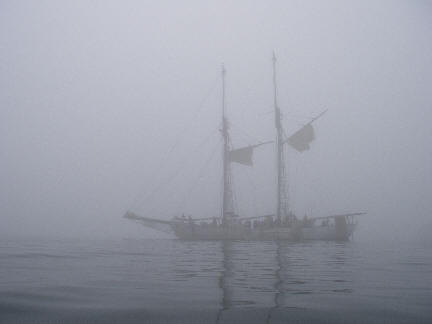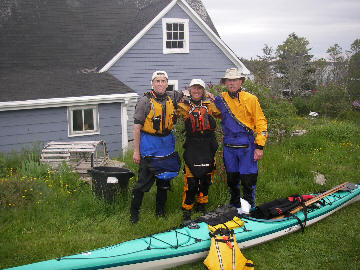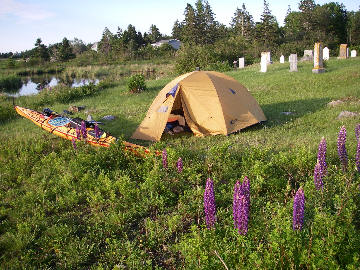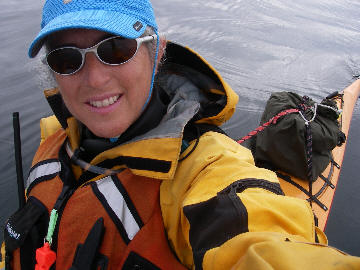Wendy Killoran

The time spent alone would console my soul, the water would sooth the hurt inside, but I needed companionship I discovered, not more solo time.
I’d paddled the north shore of the Georgian Bay in early May as a warm-up paddle to my Nova Scotia paddle. I’d paddled with a new friend, Mark, who had more than kayaking intentions. His smooth style seduced me to feel an emotional connection, and we paddled from Key River Marina to Killarney as the first kayakers of the season, revelling in the solitude and enjoying the opportunity to get to connect quite intimately. The days were blissful and I was filled with hope and optimism from this brief but uplifting journey. How was I to know that my new friend would test my emotional strength rather than encourage and support me? The ocean quenches my thirst for adventure, but this time, it would take more than repetitive strokes to quell my aching heart.
I’d launched from New Glasgow on May 25 with five paddlers from the Pictou County Paddlers Club as we paddled the East Pictou River under warm, sunny skies, quite a contrast from the wicked, cold wind and driving rain as I’d arrived in Nova Scotia. I’d arrived wondering why I’d subject myself to such ungodly conditions. But as I launched from my host, Glenn’s backyard, idyllic conditions lulled me into the excitement of commencing a new expedition. Blossom trees and the soap opera stories of local paddlers’ love dramas wafted on the spring breeze. In Pictou, we arrived as hundreds of motorcyclists roared off on a rally, departing at the historic Hector slip, where the original Scottish settlers of Nova Scotia had arrived.
My kayak was heavily laden as any kayak is at the start of a long expedition. In the following few days, I refined my packing routine to fit my gear in and on the kayak.
My first day of paddling ended at the western tip of Big Island. My entourage escorted me to the beach where I found a suitable grassy meadow to set up camp in pure sunshine and a mirror calm Northumberland Strait. Glenn miraculously offered an Alexander Keith’s India Pale Ale, a Nova Scotian brewed beer, to end a perfect paddling day. After my first full day of paddling, confidence and blissful optimism filled me.
But the second day, after a very early wake-up call from the rumbling lobster fishermen’s boats, saw me paddle with a sense of urgency. The calm sea was expected to become agitated by high winds. I’d barely paddled 1.5 hours when I found myself in growing following waves flowing parallel to the shore. I raced towards Lismore, like a galloping mare. The helpful tailwind had increased to become a hindrance, where I braced to remain in control as I entered through the harbour entrance at Lismore, racing over steepening waves. A fisherman on the dock had remarked that I was crazy to be out there kayaking in these deteriorating conditions. I was relieved but annoyed to be safely ashore so early in the day.
Little did I realize that the wind would pin me down for four days in Lismore. It was frustrating to be windbound so early into the expedition. I was fortunate that local kayaker Lynda-Marie hosted me as I awaited suitable launching conditions. I bided my time reading Daniel Hay’s On Whale Island, walking, and indulging in freshly caught lobster from Lynda-Marie’s generous neighbour.
At this point, Mark, my new friend, was keen to communicate. It was emotionally supportive to talk of my journey and to voice my opinion on the editorial in the summer 2008 issue of Adventure Kayak magazine where I’d been falsely labelled as a “mock-waiter” and even worse, “disrespectful” paddler. I felt like I’d been attacked as in a Hollywood tabloid, and though I simply needed to ignore the inaccurate but judgmental editorial, it chewed away at me. I paddle for the love of kayaking, to immerse myself completely in my environment, and for that, I was being attacked falsely. The hurtful words wounded my fragile ego. My friend provided words of support.
I paddled with Lynda-Marie a few kilometres farther towards Arisaig, but again, the Northumberland Strait was roughed up in a steep sea of waves and wind. I camped behind a storage shed at the fishing wharf in Arisaig.
Fortunately the next morning, calm conditions allowed me to make wonderful progress around Cape George, where I encountered the “Fish and Oceans” police who eyed me suspiciously as I rock-hopped close to shore. I landed near Cribbons Point where Glenn had coached me to enjoy the fish and chips which were recommended in the Canadian “Where to Dine” guide. But I was paddling in the shoulder season, and the hopeful dining experience was not to be. I cooked a pasta meal on a pebble beach as a downpour commenced. I discovered that my new MEC Wanderer 2 tent was impervious to the deluge that followed. I fell asleep to the drumming of incessant rain that percolated through the pebbles on the beach.
I’d met up with Marc, a CBC radio reporter from Moncton. He’d paddled out to meet me and we returned to his waterfront home in Antigonish Harbour. He was a most hospitable host. I met so many kind and genuinely hospitable people on my journey, and though they enriched my journey immensely, I longed to meet someone special whom I dreamed of as “Mr. Right.” Try as I might, this search for “Mr. Right” becomes more elusive the harder I try to look for him. In warm sunshine and light wind, Marc and I enjoyed a Mediterranean-style meal with a rich tasting red wine. Conversation never lagged. I shared my story with energy and vitality, like always. I felt great, yet, as Marc departed for New Brunswick, I felt the loneliness of being alone creep upon me. For several years I tried to find a compatible (and optimistically caring) partner to share in my lengthy kayak journeys. I had only found heartache and disappointments with failed romantic liaisons and partners who “used” my paddling resume to procure lucrative sponsorship deals, pronouncing me expendable once sponsorship was procured and a partner who I learned suffered from severe depression and who apparently was also a paranoid schizophrenic, who warped everything I said into bizarre and distorted perspectives before quitting the expedition, stealing hundreds of dollars of my gear and taking over my web-site without my consent. It all was very demoralizing, realizing how ugly some people become for self promotion at my expense. Yet, I coached myself into remaining optimistic, regardless of the negativity of others. Communication between Mark and me became less frequent. I was still naively unsuspecting that he was distancing himself. After all, our last meeting on his birthday on May 16 in Guelph had been the euphoric high of new lovers, with genuine smiles, hugs and steamy kisses. I believed he cared and I needed to believe that considering all the blows I’d taken, like an ill prepared boxer in a title bout.
Once I skirted St. Georges Bay at the north western tip of mainland Nova Scotia, I deliberated whether I should turn left along the western edge of Cape Breton Island or right into the Strait of Canso. I decided to save the cliffs and dramatic highlands of Cape Breton Island for a future journey. In warm sunshine and calm waters, I headed into the Strait of Canso where I needed to pass through a lock which was built to accommodate the largest freighters plying the oceans. The causeway by the lock had created local controversy as the route of the fish and marine mammals had become completely blocked. The lock assists boaters with opposing flow of tides, not with water levels. I entered the gate, sat in the middle of this lengthy enclosure and waited for one gate to close and the opposite gate to open. I’d never navigated a lock in all my years of kayaking and thus I excitedly shared my adventure with Mark by cell phone.
Near Mulgrave, just east of the lock, I landed near a home where I saw a gardener to request water. Ursula greeted me as warmly as the sun that was shining that day. I was showered with gracious hospitality by Ursula, filling my water bags, inviting me for lunch, offering me a shower, and laundering my sweaty paddling clothes. She doted over me as though I were her daughter and shared stories and her new found hobby, pioneer rug hooking. I departed feeling very upbeat and spent the rest of the afternoon battling a headwind which funnelled through the Strait of Canso, passing an unsightly industrial area. I camped in a mosquito infested woods, resorting to donning my mosquito jacket.
I continued to paddle on a daily basis, not exhausting myself with extreme distances, but rather averaging 30 to 35 kilometres daily. I crossed Cedabucto Bay and camped on a carpet of spongy moss and low berry plants near Queensport. As I launched, fishermen checked their lobster traps only 20 metres from my kayak. It was full lobster season in northern Nova Scotia.
In Canso, I was able to restock supplies and visit a CAP site, a public “computer access point.” Departing in sunshine, I paddled amongst remote shoreline, accessible only by boat. I weaved through a myriad of polished white granitic islands, discovering a large glacial erratic boulder sitting on three small stones like a tripod. It was a day that filled me with joy and happiness with colorful island scenery and a sprinkling of rustic summer huts. I rested briefly on Whale Island, the island I’d read about in Daniel Hay’s year-long journal chronicling his time spent on the island exposed to the full power of the Atlantic Ocean. I had decided to stay at the Foxberry by the Sea B&B, a century captain’s manor house situated on a sprawling lawn at water’s edge. I slept in a comfortable bed in a room with windows on three sides overlooking the island studded Whitehaven Harbour.
When I departed, a little boy watched in wonder, comfortably perched on his father’s lap. He’d never seen a kayak before and in my full Gore-Tex suit, neoprene sprayskirt, and PFD with bulging pockets, I must have resembled some unearthly being. I had used a narrow, manmade canal to cut across Whitehead Peninsula and had come across the lobster fishing boat Guns ’n’ Roses as the fishermen debated my gender, a conversation which drifted across the calm water at full volume. I was offered a lobster which I bungeed onto the kayak’s deck and which stared at me for the remainder of the day’s paddle to a sandy beach at New Harbour.
In New Harbour, at 5 a.m., I was introduced to heavy fog. When I awoke and saw dense fog and sheets of driving drizzle, I decided to snuggle under the warmth of my sleeping bag and finally awoke more than five hours later, having fallen into a deep, restorative sleep, something which often eludes me even when I feel exhausted. I had wakened and daydreamed of my short-lived adventure in early May on the Georgian Bay, reliving in my mind wonderful moments, feeling close to a man I’d bonded with so naturally. I stayed in New Harbour for the day. Since Arisaig, I’d paddled nine consecutive days without a rest day, progressing reasonably swiftly along Nova Scotia’s north shore. Again I experienced true hospitality in the home of Lillian and Winston. I believe that when I journey solo by kayak, it becomes easier to meet people and to experience their generosity as I arrive in a non-intimidating manner, from the sea, a place where many derive their livelihood, despite the economy of the declining fisheries. Thus far, I’d never felt truly alone on the water and neither truly remote, as I’d encountered dozens of lobster boats checking traps daily.
I continued to paddle southwest along a shoreline characterized by glacial till cliffs, rocky shores, and countless lurking shoals. But conditions were calm on the Atlantic Ocean, with a slight swell and ample sunshine. Mark was on my mind. I would have loved to share my journey with a partner.
Days were balanced with sunshine and then alternating with fog. Sometimes I camped, requesting permission from property owners or other times I engaged in stealth camping obscured by the cloak of fog. I also accepted offers to stay in a spare room.
One day, at Sheet Harbour Passage, just as a headwind was building, I recognized a long, green dock with a gazebo from a previous day paddle in 2006 at the restaurant “The Marquis of Dufferin” and when I requested if it was open, the man on the deck replied, “Yes.” So I enthusiastically paddled to shore with visions of a filling and delicious restaurant lunch. Once ashore however, the gentleman informed me, “This is not a restaurant, this is my home.” He had copied the dock which I’d remembered so vividly. I spent 2.5 days windbound with Mike, who was Mr. Charming on day one and then became a brooding, moody man for the next 1.5 days as offshore winds gusted between 60 and 70 km/h, fueling raging forest fires which caused road closures and home evacuations at nearby Porters Lake. During these strong offshore winds, he insisted that I leave, as the winds howled whitecaps on the bay. It was the first time ever that I allowed someone to bully me into conditions I felt dubious about and I launched with teary eyes and grit determination to find a safe haven, away from a place where I no longer felt welcome.
I had the opportunity to meet Scott Cunningham and his partner Gayle Wilson in Tangier at Coastal Adventures during their annual kayaker’s retreat and listened to Jim Price share his tales of kayak adventures in Newfoundland and Labrador. Thanks to my newfound friend, John, I was able to attend this gathering of kayakers as the wind delay in Sheet Harbour Passage had prevented me from arriving by kayak for the symposium.
The shoreline near Tangier was quite beautiful, with several long, sweeping, white sandy beaches. The beach at Wolfes Island resembled the tropics except for the fact that lobster fishermen plied the waters nearby. On Father’s Day, I paddled with Glenn and Wayne, local kayakers, around Taylor’s Head in benign conditions.
With the assistance of John, I halted my journey for 2.5 days, flying back to Ontario to attend my daughter’s graduation. When I resumed my journey, I experienced foggy conditions more and more frequently. It was disheartening. At times, visibility was limited to a radius of 50 metres. It felt like a form of sensory deprivation and I kept reminding myself I’d rather be hugging Mark than the coast! And then I’d allow my emotions to overrule my sensibility.
Near Terrance Bay, after an eventful five-kilometre crossing in suffocating fog, I met kayaker Marc unexpectedly, who appeared as an apparition from the fog. At one point in this blinding fog, I’d encountered a boat idling softly, where no one acknowledged my appearance through the fog. I continued paddling without a word, presuming I’d come across poachers as lobster season was now closed in this zone. A few minutes later, I discovered a two-masted sailboat with numerous people on board. As I approached someone yelled, “Come any closer and we’ll shoot!” and then I saw two people board a dory and one was holding a rifle. I paddled towards a nearby Zodiac, and when I asked, “What’s going on here?” with my heart pounding heavily, I was told in a whispered tone, “They’re shooting a movie.” A few minutes later, I emerged from the dense fog onto Crystal Crescent Beach in blinding sunshine, relieved to be safe ashore.
My journey continued to encounter more and more fog days. Rounding Paggy’s Cove, I kept well clear of the smooth granite shoreline as 2.5-metre swells crashed dramatically with thundering roars and towering spray as these swells had travelled the width of the Atlantic Ocean unimpeded, meeting their demise against this solid, rocky coast.
Crossing Mahone Bay in a formidable headwind, I encountered the only whales of the journey, two humpback whales, and at nearby Blue Rocks, I met the only unfriendly person of the trip, an austere German woman who would not allow me to land the kayak, insisting I continue on. The Lunenburg area was settled by Germans. The Bluenose schooner, the tall ship featured on the Canadian dime, was built in Lunenburg.
I continued to Naas Head where I camped for two nights, visiting Lunenburg and Mahone Bay and enjoying a scallop dinner with Agar and Elizabeth, a professor and his lovely wife. Their companionship and thoughtful conversation was endearing.
I spent the next five days blindly paddling through fog, relying on my maps and compass. I was tiring of staring at my built-in Ritchie deck compass near my bow, which seared an image into my retina.
Optimistically, I arrived at Mouton Island in sunshine and calm conditions. I walked the soft white beach barefoot, the sand massaging my soles, finding dozens of bleached sand dollars. I felt happy and then, early in the evening, fog descended upon me and stayed with me for three more days, reducing my visibility often to less than 50 metres.
It was becoming too much. I was approaching the southern tip of Nova Scotia and not only would the fog continue to be a huge factor but also the strong currents and high tidal ranges as the ocean is funnelled into the Bay of Fundy. The thought of navigating blindly on rushing currents did not appeal to me, nor did it seem safe.
I’d been nursing heartache. Mark had become silent, completely unattainable for several weeks. I’d wanted a confidante and needed to hear words of encouragement from him as the dense fog made me feel invisible to the world, more alone than ever. The combination of heartache and endless realms of fog made me decide that I was no longer enjoying the journey. On a beach near Lockeport, after more than a thousand kilometres of kayaking, I ended my journey with emotions tugging at my heart. How does one quell the yearning? How does one subdue heartache? The answers were not visible in the fog.



